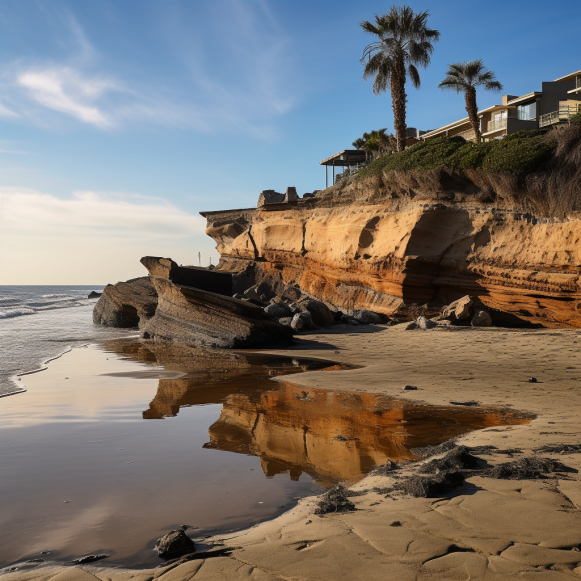‘It will get more critical’: San Diego County’s shrinking beaches

A new regional study finds that San Diego County’s beaches require costly, long-term replenishment efforts to remain the wide, sandy tourist attractions they have been for so long.
According to the San Diego Association of Governments’ 2023 “State of the Coast” report, shorelines in south Oceanside, south Carlsbad, Leucadia, and Coronado are rapidly shrinking.
According to the report, only beaches bolstered by sand dredged from nearby lagoons, harbors, and offshore deposits are maintaining or growing in width. It was presented Thursday at a meeting of SANDAG’s Shoreline Preservation Working Group.
According to some experts, most California beaches have never been the wide, sandy expanses seen in East Coast states like Florida. The majority of the West Coast’s coastline is steep, rocky, and battered by powerful waves, and the beach culture popularized by movies and advertising is largely a myth.
“Beaches are the essence of California and provide its most important aesthetic and recreational asset,” Scripps Institution of Oceanography oceanographer Reinhard Flick wrote in his 1993 paper “The Myth and Reality of Southern California Beaches.”
“Yet the widest sand beaches in Southern California have been created and are maintained by human activity,” Flick, who is now an advisory member of the SANDAG working group, said.
Over the years, massive amounts of sand have been dumped along the coast, and groins, jetties, and breakwaters have been built to keep it there.
The California Coastal Commission, which was established by voters in 1972, discourages the construction of groins and other hard retention devices along the coast because, while they may hold sand in one place, they contribute to erosion in other places. However, the commission continues to promote and, in some cases, mandate sand placement projects.
Human activity also contributes to beach erosion. Upstream development, from river dams to parking lots, halts the flow of sediment downstream. Coastal construction, such as homes and highways, prevents natural cliff and bluff erosion, which contributes to beach growth.
SANDAG has led two regional projects that have resulted in the placement of sand at various locations along the county’s coast. Those efforts occurred 11 years apart, with the most recent occurring more than a decade ago.
“We had gains after each of the regional beach projects, but they were only sustained for a couple years,” said Greg Hearon of the environmental consulting firm Coastal Frontiers, who worked on the SANDAG report.
The first project, completed in 2001, placed 2.2 million cubic yards of sand on beaches throughout the county, primarily from the San Diego harbor. It cost $18 million, with federal grants covering 60% and state grants covering 40%.
A second regional effort, completed in 2012, spent $26 million to place 1.4 million cubic yards of sand pumped from offshore deposits on beaches. The state funded 85 percent of the project, with local governments contributing the remaining 15 percent.
SANDAG has recently begun studies for a proposed third regional project, which could cost close to $40 million and be completed in several years.
Smaller-scale projects have benefited beaches along the county’s coast, but the benefits are fleeting.
Beaches in Oceanside, south Carlsbad, Leucadia, and Coronado have lost an average of 2 feet or more in width each year for the past 22 years, according to a new report.
The US Army Corps of Engineers dredges Oceanside’s harbor entrance annually for navigation, which provides sand for the city beach closest to the harbor. However, the fine-grained sediment washes away quickly, and there isn’t enough to spread very far south.
Northern Carlsbad beaches receive sand from the dredging of Agua Hedionda Lagoon, which was kept open for years by San Diego Gas & Electric Co. to provide cooling water for the Encina power plant. The Carlsbad desalination plant’s operators are now dredging the lagoon.
However, Carlsbad has nearly 7 miles of shoreline, and beaches on the southern end, in the Ponto area, are suffering. The average width is 88 feet, which is concerning, according to Hearon.
Winter storms erode Southern California beaches, while summer waves and long-shore currents help to restore and rebuild them.
“South Carlsbad just seems to be one (place) that doesn’t seem to hang onto anything,” Hearon said. “Going into a winter with a beach that is less than 100 feet long should get your attention.”
The San Elijo Lagoon restoration in 2018 brought a lot of sand to Encinitas and Solana Beach. At a nearby beach, excavated material was used to create the county’s first “living shoreline” dune system.
For stability, the experimental program added 8 acres of dunes covering a base of rock riprap and cobble and planted with native vegetation. As a result, the beach at Cardiff in southern Encinitas gained 4.5 feet in width, while Solana Beach gained 5 feet.
Encinitas and Solana Beach will also receive sand from the Army Corps of Engineers’ Coastal Storm Damage Reduction Project, which will begin this fall.
It has been under construction since 2000 and is expected to continue periodic replenishment efforts in those two cities for the next 50 years. The total cost of the project was estimated to be $167 million in 2015. The first phase of work was allocated $32 million by federal officials last year.
Even so, many San Diego County beaches are eroding.
According to the report, Oceanside’s shoreline lost an average of 2.3 feet in width at mean sea level each year from fall 2020 to fall 2022.
Oceanside has 205 feet of beach at Windward Way near the harbor, which is at its best. South of the city pier, the width narrows rapidly to just 18 feet at Buccaneer Beach and 15 feet at St. Malo. The surf crashes on rock revetments protecting seaside homes in most of south Oceanside at high tide.
Coronado’s Silver Strand lost the most width of all, shedding 3.8 feet per year on average. Coronado, on the other hand, has plenty of sand and will still be 686 feet wide in 2022.
Other beaches monitored for the report had relatively stable or slightly increasing sand levels.
Some people suggested that more data points be included in the shoreline monitoring project, which currently includes little information from the San Diego shoreline.
“There’s a lot of erosion in Tourmaline (near Mission Bay) and Point Loma, but you guys don’t collect information there,” Katheryn Rhodes explained. “These are critical areas that must be monitored.”
SANDAG intends to expand the program by allowing the public to contribute their own photographs and observations to the database via the internet.
Climate change, according to Flick, increases the importance of monitoring beach erosion.
“As sea-level rise accelerates, it will become more critical,” Flick said.
This story first appeared in the San Diego Union-Tribune.
The San Diego Union-Tribune, 2023. Visit sandiegouniontribune.com for more information. Tribune Content Agency, LLC is in charge of distribution.



